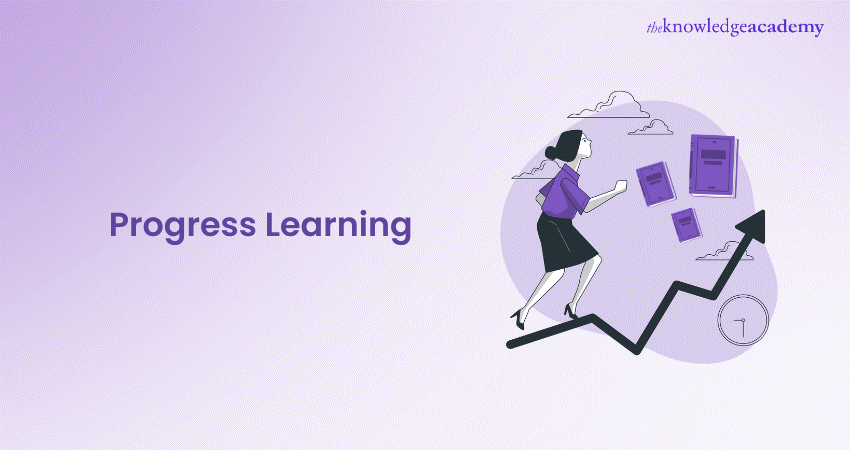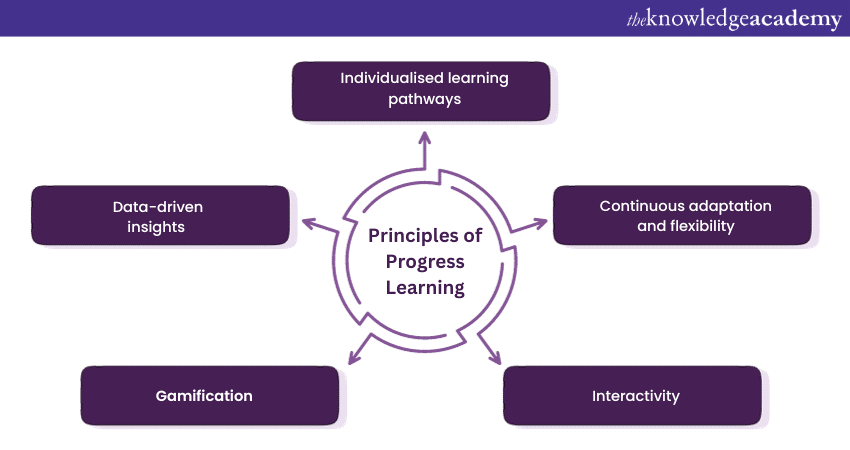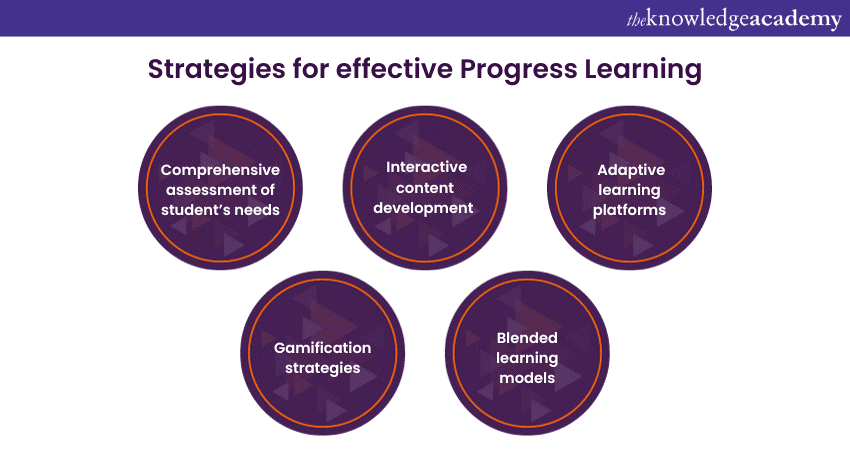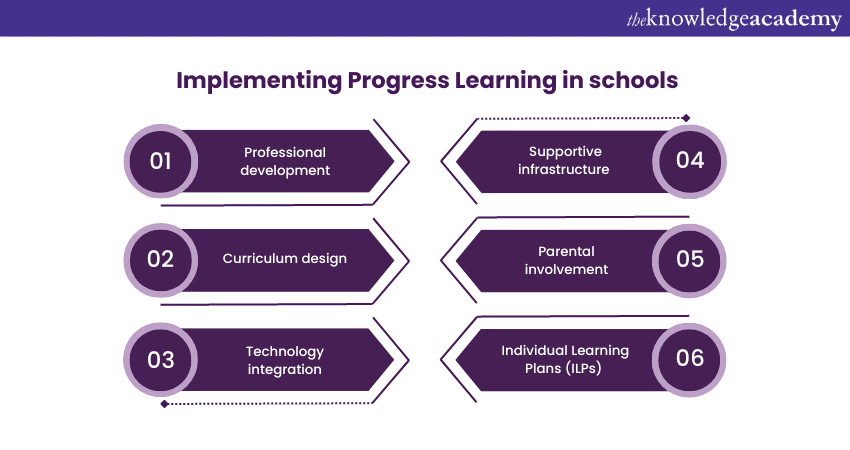We may not have the course you’re looking for. If you enquire or give us a call on +49 8000101090 and speak to our training experts, we may still be able to help with your training requirements.
Training Outcomes Within Your Budget!
We ensure quality, budget-alignment, and timely delivery by our expert instructors.

Progress Learning is crucial for transformative education. In an era where knowledge is abundant and easily accessible, it embodies the spirit of adaptability and continuous improvement. It crafts education to individual needs, leveraging technology and interactive methods to create engaging and compelling learning experiences. There are adaptive learning technologies, gamification, and blended learning, which help to shape the future of education. In this blog, we are going to explore Progress Learning, its various principles, and most importantly, the advantages of using it for education.
Table of Contents
1) What is Progress Learning?
2) Principles of Progress Learning
3) Strategies for effective Progress Learning
4) Implementing Progress Learning in schools
5) Role of technology in Progress Learning
6) Advantages of Progress Learning
7) Conclusion
What is Progress Learning?
Progress Learning can be referred to as a dynamic educational paradigm where personalised learning takes centre stage. Unlike traditional methods, it adapts to the unique needs, pace, and learning styles of individual students. At its core, it integrates advanced technologies, data analytics, and interactive methodologies to craft tailor-made educational experiences.
Through adaptive learning algorithms, it identifies individual learners' strengths and weaknesses, customising content to maximise comprehension. Gamification elements, such as rewards and challenges, enhance engagement and motivation. Progress Learning isn't just about acquiring knowledge; it's about nurturing critical thinking, creativity, and problem-solving skills. It also helps learners prepare for the challenges they can face in life. It represents a student-centric, future-ready approach to education, where each learner's journey is uniquely crafted for optimal growth and success.
Transform your leadership skills and inspire excellence with our Leadership Training
Principles of Progress Learning
Here are some principles of Progress Learning:

Individualised learning pathways
Progress Learning recognises the diversity in learning styles and preferences. It tailors educational content to individual needs, ensuring that each learner receives a customised experience. Personalised learning paths address specific strengths and weaknesses, fostering a deeper understanding of the subject matter.
Continuous adaptation and flexibility
It is adaptive and flexible. It adjusts its pace according to the learner's progress, allowing them to go deeper into challenging topics or move swiftly through familiar ones. This adaptability ensures that every student is included, catering to both fast and slow learners.
Interactivity
Interactive learning forms the cornerstone of Progress Learning. Engaging multimedia content, real-time feedback, and collaborative projects enhance the learning experience. Interactive platforms facilitate discussions, peer-to-peer learning, and teacher-student interactions, creating a vibrant educational community.
Gamification
Integrating game elements, such as rewards, challenges, and competition, gamifies the learning process. Gamification not only makes learning enjoyable but also boosts motivation and engagement. It instils a sense of achievement, encouraging learners to participate and progress actively.
Data-driven insights
It relies on data analytics to gain insights into student performance. Advanced algorithms analyse learning patterns, strengths, and weaknesses. Educators can use this data to refine teaching strategies, provide targeted interventions, and offer additional support where needed.
Collaborative learning
Progress Learning encourages collaboration and teamwork. Group projects, online forums, and collaborative assignments promote social learning. Peer interaction enhances communication skills, teamwork, and the ability to articulate ideas effectively.
Lifelong learning
It instils a passion for lifelong learning. It prepares individuals not just for exams but equips them with skills essential for a constantly evolving job market. Lifelong learning becomes a habit, ensuring professionals remain competitive and adaptable throughout their careers.
Inclusivity
It is designed to be inclusive. It accommodates diverse learning needs, including those of individuals with disabilities. Accessible interfaces, subtitles, and alternative formats ensure that education is accessible to everyone, regardless of their physical or cognitive abilities.
Empowerment
It instils confidence, curiosity, and a thirst for knowledge. Learners become active participants, taking control of their education and shaping their futures.
Unlock your full leadership potential and drive success with our Leadership Skills Training. Join now!
Strategies for effective Progress Learning
Here are several strategies that can used for effective Progress Learning. They are as follows:

Comprehensive assessment of students’ needs
Conduct thorough evaluations to understand the diverse needs and learning styles of students. Gather data on their strengths, weaknesses, interests, and prior knowledge to create personalised learning paths.
Interactive content development
Design engaging and interactive multimedia content, including videos, simulations, and gamified exercises. Interactive elements capture attention, enhance understanding, and promote active participation.
Adaptive learning platforms
Implement adaptive learning technologies that analyse students' performance data in real time. These platforms adjust the difficulty level and content based on individual progress, ensuring a tailored learning experience.
Gamification strategies
Incorporate gamification elements, including badges, leaderboards, and rewards, into the system. Gamified challenges boost motivation, encouraging students to complete tasks, participate actively, and strive for achievements.
Blended learning models
Combine online learning resources with traditional classroom interactions. Blended learning provides a balanced approach, allowing students to benefit from both digital materials and face-to-face discussions, fostering a supportive learning environment.
Regular assessments and feedback
Implement continuous assessments and provide timely, personalised feedback. Periodic evaluations help identify areas of improvement, enabling educators to address individual challenges promptly.
Peer collaboration and group activities
Encourage collaboration through group projects, discussions, and peer-to-peer learning. Collaborative activities enhance communication skills, promote teamwork, and provide diverse perspectives, enriching the learning experience.
Data-driven decision-making
Utilise data analytics to track student progress and assess the effectiveness of teaching methods. Data-driven insights enable educators to refine strategies, identify learning gaps, and offer targeted support.
Professional development for educators
Offer educators training and professional development opportunities to help them adapt to evolving teaching methodologies and technologies. Empowered teachers can effectively implement Progress Learning strategies in the classroom.
Accessibility and inclusivity
Ensure that learning materials and platforms are accessible to all students, including those with disabilities. Implement features like screen readers, subtitles, and alternative formats to create an inclusive learning environment.
Parent and community engagement
Include parents and the local community in the educational journey. Involve parents and the community in the learning process. Regular communication and involvement foster a supportive network, enhancing students' motivation and overall learning experience.
Encourage self-directed learning
Promote self-directed learning by encouraging students to explore topics of interest independently. Provide resources and guidance, allowing them to pursue knowledge beyond the curriculum and fostering a lifelong learning mindset.
Enhance your critical thinking skills and drive creativity in your leadership role with our Creative and Analytical Thinking Training.
Implementing Progress Learning in schools
Implementing Progress Learning in schools requires a thoughtful and systematic approach that integrates innovative teaching methods, technology, and personalised learning experiences. Here’s how schools can successfully transition to a Progress Learning model:

a) Professional development: Educators need training to utilise Progress Learning tools and techniques effectively. Workshops, seminars, and online courses can empower teachers with the skills to design engaging and interactive lessons.
b) Curriculum design: Revise the curriculum to incorporate adaptive learning materials and interactive content. Align the curriculum with individual learning goals, ensuring that each student receives a customised educational experience.
c) Technology integration: Schools must invest in adaptive learning platforms, educational software, and digital resources. These tools analyse students’ performance data, providing real-time feedback and adapting content to their needs.
d) Supportive infrastructure: Ensure schools have a robust IT infrastructure, including high-speed internet, updated devices, and multimedia facilities. A seamless technological environment is essential for the effective implementation of Progress Learning methodologies.
e) Parental involvement: Keep parents informed and engaged in their child’s Progress Learning journey. Regular updates on progress, access to online platforms, and workshops for parents can create a supportive home environment, reinforcing the learning process.
f) Individual Learning Plans (ILPs): Develop ILPs for each student, outlining their learning objectives, strengths, and areas for improvement. ILPs serve as roadmaps, guiding educators in tailoring content and activities to meet individual student needs.
g) Assessment and feedback: Shift from traditional exams to continuous assessments, projects, and interactive quizzes. Instant feedback from educators and adaptive platforms empowers students to gauge their progress and identify areas that need attention.
h) Collaborative learning spaces: Design classrooms that facilitate group activities, discussions, and collaborative projects. Flexible learning spaces encourage interaction, teamwork, and peer-to-peer learning, enhancing the overall learning experience.
i) Monitoring and evaluation: Regularly monitor the effectiveness of Progress Learning strategies. Analyse student performance data, collect feedback from teachers, students, and parents, and make necessary adjustments to improve the learning process continually.
j) Inclusive education: Ensure that Progress Learning methods are accessible to all students, including those with disabilities. Leverage adaptive technologies, offer supplementary assistance, and establish an inclusive environment where all students can flourish.
Sharpen your decision-making process and lead with confidence. Register now for our Decision-making Skills Training.
Role of technology in Progress Learning
Technology plays an essential role in shaping the landscape of modern education, particularly in the realm of Progress Learning. Its integration into educational frameworks has transformed traditional classrooms into dynamic, interactive, and personalised learning environments. Here’s how technology is revolutionising education through Progress Learning:
a) Personalised learning paths: Technology enables the creation of adaptive learning platforms that analyse students' strengths, weaknesses, and learning styles. Using sophisticated algorithms, these platforms tailor educational content to match individual needs, ensuring that each student progresses at their own pace. This personalisation enhances understanding, engagement, and retention of knowledge.
b) Interactive and engaging content: Digital tools provide access to interactive multimedia content, including videos, simulations, and virtual labs. T These educational materials captivate students with visually captivating and immersive experiences, making intricate concepts easier to comprehend and enjoy. Interactive content fosters active participation, critical thinking, and problem-solving skills.
c) Data-driven decision-making: Technology generates vast amounts of data on student performance, interactions, and progress. Educators can utilise this data to extract insights about learning patterns, pinpoint areas for enhancement, and assess the efficacy of teaching approaches. Data-driven decision-making allows for targeted interventions and personalised feedback, enhancing the overall learning experience.
d) Gamification and motivation: Educational software incorporates gamification elements such as badges, rewards, and leaderboards. Gamified learning experiences enhance motivation, encouraging students to complete tasks, achieve goals, and compete with peers. This competitive yet supportive environment boosts engagement and persistence in learning.
e) Blended learning environments: Technology facilitates blended learning models, seamlessly integrating online resources with traditional classroom interactions. Virtual classrooms, online discussions, and collaborative projects create opportunities for students to engage with both peers and educators, cultivating a sense of community and enriching social learning encounters.
f) Accessibility and inclusivity: Assistive technologies cater to diverse learning needs, making education accessible to students with disabilities. Screen readers, speech recognition software, and captioning tools play a pivotal role in ensuring the inclusivity of educational content. They enable every student to engage fully in the learning process, regardless of their abilities or preferences.
g) Collaborative learning tools: Technology enables collaborative learning beyond the confines of the classroom. Online platforms and tools facilitate group projects, peer reviews, and collaborative research, promoting teamwork, communication skills, and the exchange of diverse perspectives.
h) Global learning communities: Digital platforms connect students and educators from around the world. Online forums, webinars, and collaborative projects create global learning communities where students can interact with diverse cultures, perspectives, and ideas, broadening their horizons and fostering a global mindset.
i) Preparation for future skills: The integration of technology equips students with vital digital literacy skills, ensuring they are well-prepared for the requirements of the future job market. Proficiency in using digital tools, critical thinking, and problem-solving abilities are crucial skills that students develop through technology-enabled education.

Advantages of Progress Learning
Progress Learning offers a plethora of advantages that significantly enhance the educational experience for students, educators, and institutions alike. These advantages are as follows:
1) Personalisation and customisation: Progress Learning crafts educational content according to individual learning styles and needs, ensuring a personalised learning journey for each student. This customisation fosters more profound understanding and retention of knowledge.
2) Enhanced engagement: Interactive and gamified elements in Progress Learning capture students' attention and maintain their interest, increasing engagement and motivation. Students actively participate in their learning, leading to more profound comprehension.
3) Improved learning outcomes: The adaptability of Progress Learning ensures that students grasp concepts thoroughly before moving forward, leading to better learning outcomes. Customised feedback and targeted interventions bridge knowledge gaps, enhancing overall academic performance.
4) Lifelong learning skills: Progress Learning instils crucial skills such as critical thinking, problem-solving, and digital literacy. These skills are essential not only for academic success but also for lifelong learning and success in the rapidly evolving job market.
5) Accessibility and inclusivity: Progress Learning embraces diverse learners, including those with disabilities, by providing accessible content and assistive technologies. This inclusivity ensures that education is accessible to all, promoting equality and empowering every individual to learn and grow.
Elevate your practical thinking abilities with our Practical Thinking Masterclass. Sign up now!
Conclusion
Progress Learning represents a unique shift in education, transforming the way people learn and grow. By embracing personalised, interactive, and adaptive methods, education becomes not just a means to an end but a lifelong journey of discovery and improvement. As we move forward, it is crucial to address challenges, ensure inclusivity, and harness the full potential of technology to create a future where education knows no bounds. Embracing Progress Learning means embracing a brighter, more knowledgeable future for all.
Empower your leadership decisions with actionable intelligence only with our Data to Insights Training. Join now!
Frequently Asked Questions
Upcoming Business Skills Resources Batches & Dates
Date
 Staff Motivation Training
Staff Motivation Training
Fri 7th Feb 2025
Fri 28th Mar 2025
Fri 6th Jun 2025
Fri 1st Aug 2025
Fri 3rd Oct 2025
Fri 5th Dec 2025







 Top Rated Course
Top Rated Course


 If you wish to make any changes to your course, please
If you wish to make any changes to your course, please


